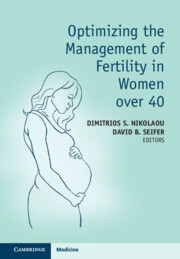Book contents
- Optimizing the Management of Fertility in Women over 40
- Optimizing the Management of Fertility in Women over 40
- Copyright page
- Dedication
- Contents
- Contributors
- Introduction
- Section 1 Demographic Trends
- Section 2 Biological Basis of Female Reproductive Aging: What Happens to the Ovaries and the Uterus as they Age?
- Section 3 Lifestyle, Environment, and Optimizing Reproduction in the 40s
- Section 4 Rethinking and Redefining “Family Planning” for the Twenty-First Century
- Section 5 Optimal Deployment of ART beyond 40
- Section 6 Obstetric Management beyond 40
- Chapter 10 Optimal Management of the First Trimester in Women over 40
- Chapter 11 Optimal Management of Pregnancy beyond 12 Weeks, Labour and the Puerperium for Women over 40
- Section 7 Children of Older Parents
- Section 8 What Are Realistic Alternatives to Conceiving with Autologous Eggs?
- Section 9 New Technologies
- Section 10 Ethics
- Index
- References
Chapter 10 - Optimal Management of the First Trimester in Women over 40
from Section 6 - Obstetric Management beyond 40
Published online by Cambridge University Press: 15 September 2022
- Optimizing the Management of Fertility in Women over 40
- Optimizing the Management of Fertility in Women over 40
- Copyright page
- Dedication
- Contents
- Contributors
- Introduction
- Section 1 Demographic Trends
- Section 2 Biological Basis of Female Reproductive Aging: What Happens to the Ovaries and the Uterus as they Age?
- Section 3 Lifestyle, Environment, and Optimizing Reproduction in the 40s
- Section 4 Rethinking and Redefining “Family Planning” for the Twenty-First Century
- Section 5 Optimal Deployment of ART beyond 40
- Section 6 Obstetric Management beyond 40
- Chapter 10 Optimal Management of the First Trimester in Women over 40
- Chapter 11 Optimal Management of Pregnancy beyond 12 Weeks, Labour and the Puerperium for Women over 40
- Section 7 Children of Older Parents
- Section 8 What Are Realistic Alternatives to Conceiving with Autologous Eggs?
- Section 9 New Technologies
- Section 10 Ethics
- Index
- References
Summary
Women over the age of 40 years are at a higher risk of early pregnancy complications such a miscarriage or ectopic pregnancy. They are also more likely to have pre-existing medical conditions which further increase their risk of early pregnancy pathology, for example, previous pelvic inflammatory disease leading to a tubal ectopic, or uncontrolled diabetes increasing the risk of a miscarriage. Women in this age group are also more likely to have conceived through fertility treatment, and may present with complications of this, such as multiple pregnancy or ovarian hyperstimulation syndrome. A woman’s history of assisted reproductive technology and pre-existing subfertility is significant not only in accurately dating the pregnancy but also with regards to the psychological impact in case of a poor outcome. Early pregnancy units have become well established in most hospitals as a dedicated department providing specialist early pregnancy care. This chapter provides an overview of the optminal management of the first trimester of pregnancy for women over 40 and the management of the common conditions.
Keywords
- Type
- Chapter
- Information
- Optimizing the Management of Fertility in Women over 40 , pp. 119 - 130Publisher: Cambridge University PressPrint publication year: 2022



